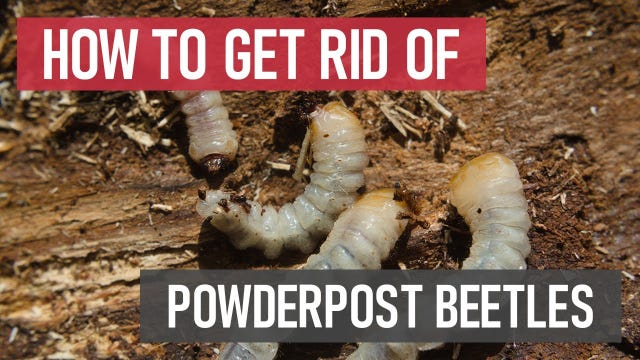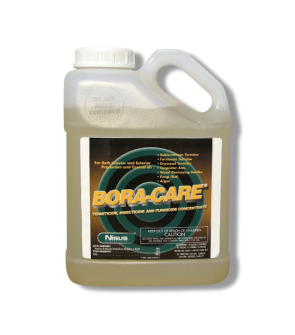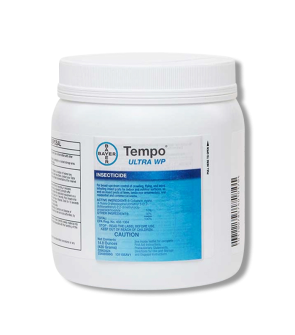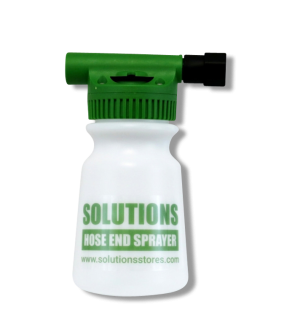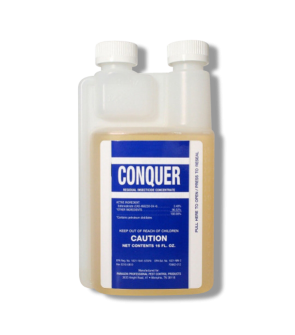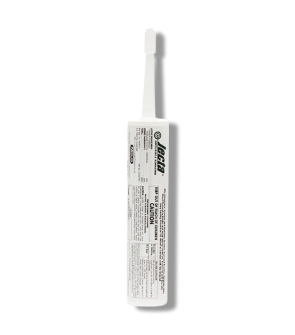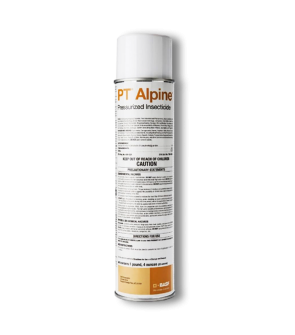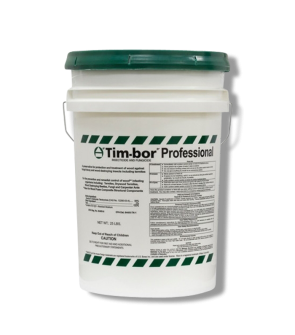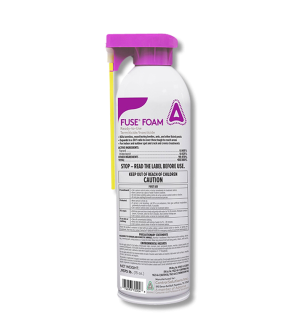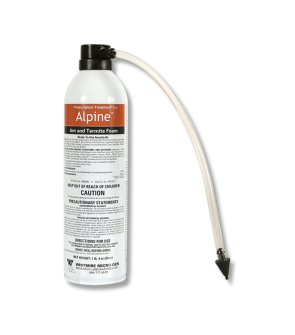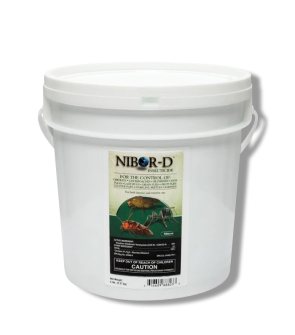Gain access to personalized product screening, the best pricing, rewards, and more!
Most Effective Products
Powderpost Beetle Control: How To Get Rid of Powderpost Beetles
This page is a general powderpost beetle control guide. Using the products and methods suggested, you will get control of powderpost beetles. Follow this guide and use the recommended products, and we guarantee 100% control over powderpost beetles.
Regarding wood-destroying bugs, the usual suspects are termites and carpenter ants. Another common pest that often goes under the radar but enjoys feeding on and destroying wood is the powderpost beetle. This beetle species earned the “powder post” part of its name because the larvae feed on wood, and if given enough time, they can break down the wood until it becomes merely powdery dust.
Powderpost beetles infest homes because they need wood to lay their eggs. They deposit their eggs when they penetrate and make holes inside the wood, where the eggs turn into larvae and feed on the wood until reaching maturity. It typically takes up to 5 years before the larvae will mature into adults, which means a lot of feeding on wood and furniture.
If you are experiencing an infestation of powderpost beetles on your property, follow our DIY guide below, which explains more about this insect and how to get rid of powderpost beetles using expert how-to advice and professional powderpost beetle treatment products.
Identification
The first step is identifying the pests and ensuring they are powderpost beetles, not insects. Misidentification of the powderpost beetle can lead to using the wrong treatment products, wasting time and money. Here are some traits to watch out for when identifying powderpost beetles:

- There are several different species of pests that are described as powderpost beetles. Generally, the adults of these beetles are small insects, ranging from 1/16 to 1/4 inches long. They have flat-shaped cylindrical bodies and vary in color from light brown, reddish-brown to black. Their protective wings feature distinct pit-like rows, giving them a hardened appearance. The head is often visible from above and they have short, segmented antennae.
- Powderpost beetles go through several stages similar to a fly or a flea. Starting from an egg, they develop into larvae, pupae, and then adults.
- Common types of powderpost beetles include lyctids, bostrichids, and anobiids. Lyctids have narrow, elongated bodies once they’ve pupated into adults. After pupation, they emerge from wood creating exit holes about the size of a pinhead. Lyctid powderpost beetles prefer to target hardwoods like oak, ash, or cherry. They typically target flooring, door and window frames, and furniture, and they are not likely to target structural components like beams since those are usually made with softwood.
- Bostrichids have stouter bodies. Their heads are oriented downwards, creating a humped or hooded appearance, and some may have a pair of spines protruding the tail ends of their bodies. Like lyctids, bostrichid powderpost beetles usually infest hardwoods. The holes they produce can reach up to 1/4 of an inch in diameter.
- Anobiids are convex in shape. These powderpost beetles are sometimes confused for drugstore beetles or cigarette beetles, but be aware that drugstore and cigarette beetles target stored products instead of wood. Anobiid powderpost beetles target hardwood and softwood and may cause serious damage to wooden structural components.
- Powderpost beetle larvae, also called borers, are small, creamy-white to yellowish, soft-bodied grubs that are C-shaped. They have a distinct, segmented body with a slightly larger head and small jaws they use to chew through wood. The larvae are typically about 1/8 to 3/4 inch long, depending on their age and species. Although legless, they can move slightly by wriggling. You won’t usually see them unless you cut into infested wood, as they stay hidden inside while tunneling and feeding for months or even years.
- Powderpost beetle pupae are soft, pale, and somewhat translucent usually creamy white to light yellow in color. They resemble adult beetles in shape but are immobile and soft-bodied, with their legs, antennae, and wings visible but folded tightly against the body. The pupa is typically found deep inside the wood, within a protective chamber formed at the end of the larval tunnel. Over time, the pupae gradually darken as they develop into adults.
Use the description and image above to help you properly identify powderpost beetles. If you are not sure or are having trouble, contact us, and we will try to assist with identification.
Inspection
Once you are certain that you have powderpost beetles, you need to know where this pest is located and if you have an active infestation. During the inspection, you will look for the obvious signs of a powderpost beetle infestation.

Where To Inspect
Powderpost beetles mainly infest dry, seasoned hardwoods such as oak, ash, maple, hickory, and bamboo, where they lay their eggs in cracks or pores of unfinished or poorly sealed wood. They may also infest softwoods and are more likely to be found in areas with higher moisture levels in wood, such as crawlspaces, basements, or attics.
These beetles prefer wood that has not been properly sealed or treated, making older homes, furniture, and wood flooring common targets.
Indoors, inspect attics, wood paneling, doors, basements, crawlspaces, garages, storage rooms, furniture, beams, joists, structural joints, and anywhere else there is exposed wood.
Outdoors, powderpost beetles typically infest firewood/wood piles, lumber stacks, fence posts, wooden decks, barns, foundations, exposed wood on and around buildings, and untreated wood siding or trim around structures.
They are also known to attack dead or dying trees, branches, and logs where the wood has begun to dry out. Trees such as oak, walnut, mahogany, hickory, ash, and maples are common species.
What To Look For
Signs of powderpost beetle damage include small, round exit holes in wood surfaces, typically about 1/32 to 1/16 inch in diameter, where adult beetles have emerged. These holes may appear scattered or appear in clusters.
Near these holes, you will often see fine, powdery wood powder (frass) piled up on the floor or falling from the wood. You should also check if the shavings you spot are recent or old. This can be indicated by observing the color. New frass and wood dust are a fine sandy color.
The wood itself may sound hollow or feel weak and brittle due to internal tunneling by larvae.
Over time, heavily infested wood can develop surface cracking, blistering, splitting, or flaking as the internal structure breaks down.
In some cases, infested wood may develop a musty, moldy, or slightly sour smell due to wood decay or the presence of fungi that sometimes grow in moist, damaged wood. This odor isn’t directly from the beetles but rather from the conditions that allow them to thrive.
Treatment
Now that you have confirmed powderpost beetle activity, it is time to begin treatment. Remember to read all product labels, follow the application instructions on them, and stay safe by wearing personal protective equipment (PPE).
Our top recommendations for powderpost beetle treatment are Tim-Bor Professional Insecticide and Fipro Aerosol. Tim-Bor Professional Insecticide will be used on the pieces of unfinished wood, which should be protected for various years. Fipro Foaming Aerosol will treat active sites where powderpost beetles have burrowed into wood.
Step 1: Wood Treatment with Timbor

To treat wood infested with powderpost beetles, apply a product like Tim-Bor.
Tim-Bor is a versatile wettable powder that can be applied to protect wood from insects or fungi. This product must be mixed with water before application.
Once mixed, apply your solution with a handheld sprayer. For general liquid spray applications, mix a 10% or 15% solution by mixing 1.0 or 1.5 pounds of product into 1 gallon of water.
Spray your solution onto exposed wood. TimBor protects treated wood as long as it is not exposed to rain or flooding.
Thoroughly wet the wood surface area. The application may also be made by drilling and then injecting the liquid solution under pressure into sound wood or until run-off is observed coming from entry/exit holes of infested wood.
Step 2: Apply Fipro Foaming Aerosol
After you have allowed Tim-Bor to dry, apply FiPro Foaming Aerosol.
FiPro Foaming Aerosol is made with fipronil, a non-repellent insecticide. This foam product quickly expands to cover all surfaces in a crack, crevice, or void.
To use Fipro Foaming Aerosol, you might have to drill holes to inject this product into the wood, and you can inject the product with the help of the accompanying applicator tip.
In holes where pests have been observed, spray long enough for the product to expand and cover the entire surface area. When applied properly, beetles will travel through the treated areas normally and make contact with the chemical. Beetles affected by FiPro will have their nervous systems impacted and die within a few hours. One application of FiPro will control treated areas for up to 30 days.
Apply the Fipro to treat for powderpost beetles in areas such as crawl spaces, attics, unexposed wooden elements inside walls, galleries, or other potential harborages.
Prevention
You don't want them to return after you have treated and eliminated the powderpost beetle infestation. Prevent powderpost beetles from coming back by implementing the following measures:
- Start by inspecting every new piece of wood you bring into the home. Make sure every piece of furniture or wood has been varnished, waxed, painted, and completely dried, either air-dried or kiln-dried and that there are no high moisture levels inside the wood that will prevent powderpost beetles.
- Also, store all wood products away from your home and wooden structure, and remember to use new wood when replacing a structural joint in the home.
- Keep wood areas dry and well-ventilated, since powderpost beetles prefer wood with higher moisture content. Regularly inspect wooden structures, furniture, and flooring for signs of damage, and address any moisture problems promptly by fixing leaks or improving drainage.
- Finally, make regular reapplications of FiPro Foaming Aerosol. FiPro will protect treated areas for up to thirty days, so a once-a-month treatment schedule will protect your home year-round.
Key Takeaways
What are Powderpost Beetles?
- Powderpost beetles are damaging wood-boring pests that can infest wood. They lay eggs, and their larvae feed on wood until adulthood. Powderpost beetle damage is similar to termite damage, with the difference that the larvae are most destructive.
How To Get Rid of Powderpost Beetles
- Our top recommendations for powderpost beetle treatment are Tim-Bor Professional Insecticide for unfinished wood treatment and Fipro Foaming for finished wood treatment where the powder post beetle has created galleries or has actively damaged wood.
Preventing Powderpost Beetle Reinfestation
- Prevent powderpost beetle invasions by reducing moisture around the home and applying Tim-Bor Professional Insecticide preventative treatments.






